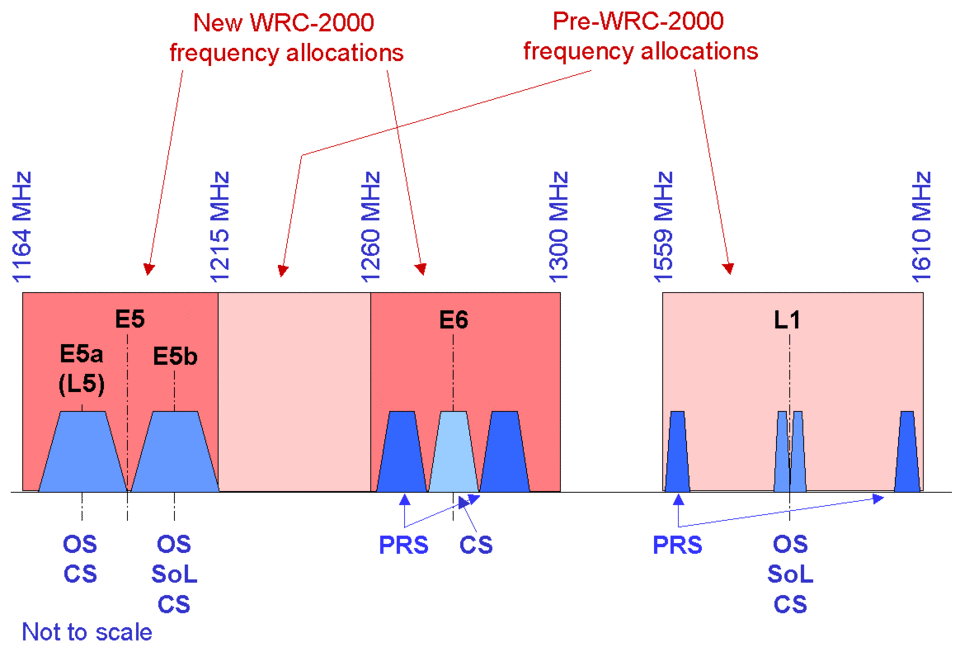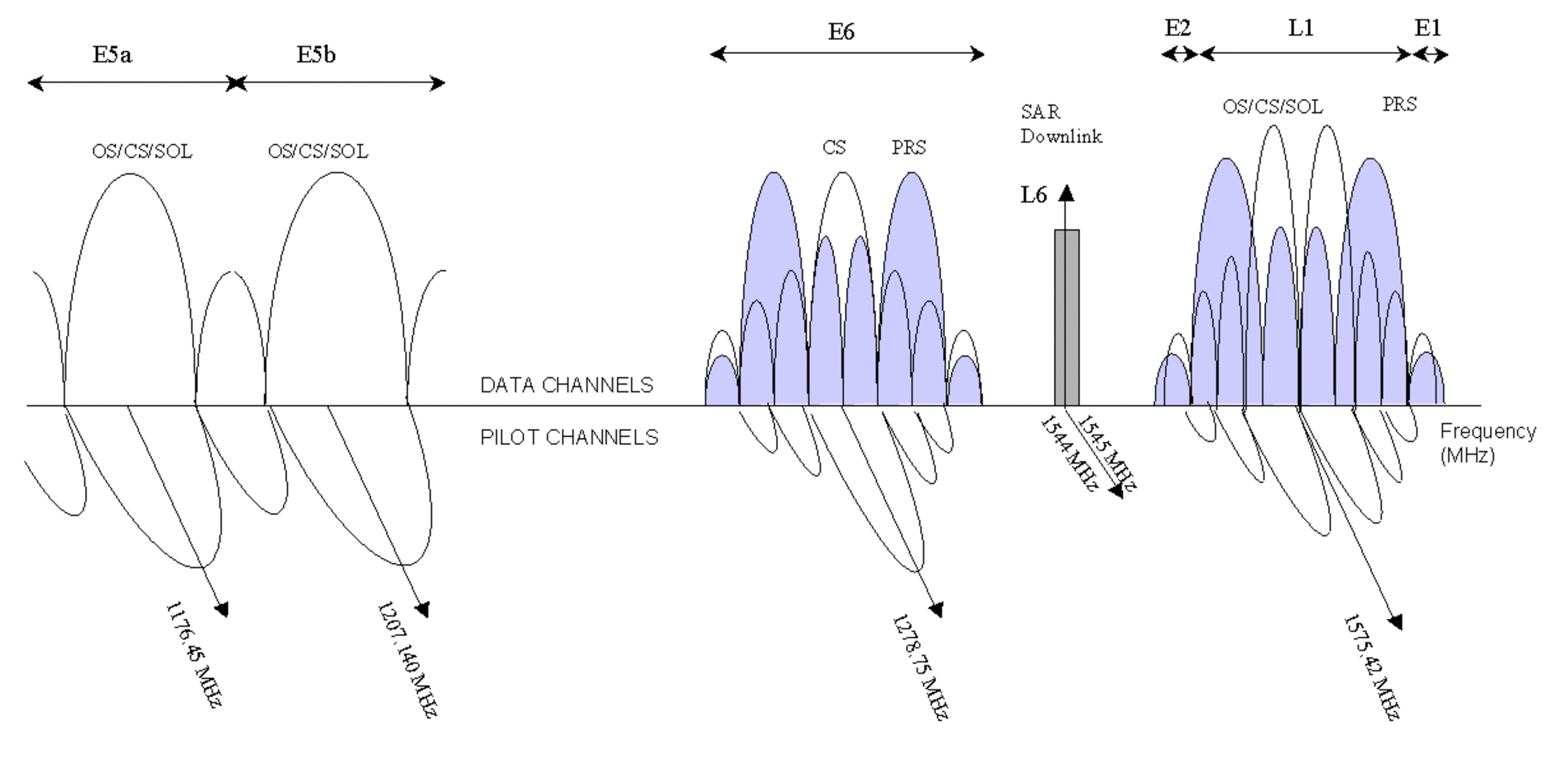Galileo navigation signals and frequencies
Galileo receivers receive the signals broadcast by the Galileo satellites and process them to compute position. Through this processing, the receivers extract measurements giving an indication of the distance from the user to the satellite.
They also decode the Galileo navigation data, which contain fundamental pieces of information for computing the user position such as the position of the satellites and the satellite clock errors as determined by the Galileo ground segment and up-linked regularly to the Galileo constellation.
The frequencies used by the satellites are within the 1.1 to 1.6 GHz band; a range of frequencies particularly well suited for mobile navigation and communication services.
Each Galileo satellite will broadcast 10 different navigation signals making it possible for Galileo to offer the open (OS), safety-of-life (SOL), commercial (CS) and public regulated services (PRS).
A distinction is made between signals containing navigation data (the data channels) and signals carrying no data (pilot channels). In the diagram this is highlighted by plotting the data channels and the pilot channels in orthogonal planes, a means of indicating that the signals of the data and pilot channels are shifted by 90 degrees in phase, which allows for their separation in the receivers.
Galileo signals have codes
All the satellites transmit at the same frequency, that is, the Galileo signal at L1 is broadcast at 1575.42 MHz from any satellite. To allow the receivers to distinguish which satellites the signals are coming from and to allow the receivers to measure the time it took the signal to travel from the satellite to the receiver (the basic measurement used for position determination), a code is added to the signal. This code is different for each satellite and its design is one of the many arts involved in making a good satellite navigation system.
A long code would allow tracking of very faint signals, such as those received inside a building, but it would be very difficult to acquire because a receiver acquires the signal by searching for the delay of the received code and for a long code there are more possibilities than for a shorter code.
Shorter codes are good for achieving fast acquisition but may lead to false acquisitions of satellites when a receiver confuses the signal between two satellites. This is because the capability of a receiver to distinguish between two different codes is inversely proportional to the length of the codes.
The code is like a key. When a receiver attempts to acquire a satellite signal, it compares the code of the received signal with a local replica stored on the receiver. When the two codes match, the receiver channel is open, otherwise the receiver tries with another code corresponding to another satellite till it succeeds.
However, not all the elements of the code need to match precisely and it is sufficient if the two codes are close enough. This means that the more complex the keys are, that is, the longer the codes, the more difficult it is to confuse keys, and therefore to mix up satellites.
Why so many different Galileo signals ?
In the end, a good engineering compromise has been found, but since those compromises may not satisfy all type of users (an indoor, static user may like long codes, while outdoor, fast-moving users would prefer short codes), the solution has been to provide alternative codes with different characteristics on the various Galileo signals. This is one of the reasons why there are so many signals.
In GPS only one signal is available, which does not allow the kind of optimisation performed for Galileo. This will be overcome with the GPS modernisation programme, where more GPS signals will be made available.
Another reason for having so many signals in Galileo is to allow the receiver to estimate the ionospheric delay error. This error is due to the delay that the navigation signals suffer when they travel through the ionosphere. This delay makes the distance from the satellite to the user, as measured by the receiver, appear longer than it actually is and if not corrected would lead to large positioning errors. Fortunately, this delay is proportional to the frequency of the signal, with lower frequency signals experiencing a longer delay than higher frequency signals. Therefore, by combining measurements to the same satellite at two different frequencies it is possible to produce another measurement where the ionospheric delay error has been cancelled out. This cancellation becomes more effective as the separation between the two frequencies increases. This is the reason why Galileo services are generally realised using pairs of signals.

The open services are realized by using the signals at L1, E5a and E5b, whether data or pilot. Several combinations are also possible, such as a dual frequency service based on using L1 and E5a (for best ionospheric error cancellation) or single frequency services (at L1, E5a, E5b or E5a and E5b together) in which case the ionospheric error is removed using a model, and even triple frequency services using all the signal together (L1, E5a and E5b), which can be exploited for very precise, centimetric applications.
The safety-of-life services are based on the measurements obtained from the open signal and use the integrity data carried in special messages designated for this purposed within the open signals. The safety-of-life service is like a data channel within the open signals.
The commercial service is realized with two additional signals in the 1278.75 MHz band plus also the capability to include commercial data within the open signals.
The Public Regulated Service is realized by two signals, one in the 1575.42 MHz band and the other in the 1278.75 MHz band. These signals are encrypted, allowing the implementation of an access control scheme.
Finally, the distinctive shape of the spectrum of the signals is due to the special modulation adopted for Galileo. This modulation has been chosen to avoid interference with other satellite navigation systems within the same band, which is indeed the case of GPS at L1. The modulation adopted is called BOC(1,1), meaning Binary Offset Carrier of rate (1,1). This kind of modulation allows GPS and Galileo signals to occupy the same frequency while avoiding mutual interference. This makes building receivers that use both GPS and Galileo simpler, because GPS and Galileo use the same frequency.















 Germany
Germany
 Austria
Austria
 Belgium
Belgium
 Denmark
Denmark
 Spain
Spain
 Estonia
Estonia
 Finland
Finland
 France
France
 Greece
Greece
 Hungary
Hungary
 Ireland
Ireland
 Italy
Italy
 Luxembourg
Luxembourg
 Norway
Norway
 The Netherlands
The Netherlands
 Poland
Poland
 Portugal
Portugal
 Czechia
Czechia
 Romania
Romania
 United Kingdom
United Kingdom
 Sweden
Sweden
 Switzerland
Switzerland

























